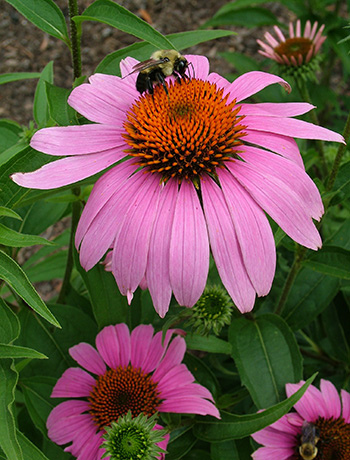Garden Talk

HORTICULTURAL HIGHLIGHT: Purple Coneflower

In this series, the staff of Duke Gardens highlights plants you’ll find within our 55-acre living collection. This week assistant horticulturist Nick Schwab features one of his favorite plants for butterflies and birds.
Botanical name: Echinacea purpurea
Common name: Purple Coneflower
Family name: Asteraceae (Aster Family)
Plant type: Perennial
Native range: Eastern North america
Location in Duke Gardens: Doris Duke Center Gardens, Historic Gardens, Blomquist Garden
Size: Clumps 2 to 5 feet tall by 1.5 to 2 feet wide
USDA Hardiness Zones: 3-8
I love working on my home garden, but it can be tough sometimes to find the time to keep it looking in tip-top shape. There are some plants you can add to your garden to make it a little easier on yourself. One of those plants is purple coneflower, an excellent low maintenance native plant that is drought tolerant once established.

Purple coneflower is a perennial that grows 2 to 4 feet tall and has beautiful flowers that stand atop a stiff rough stem. They are composed of an orange central cone surrounded by purple petals. This plant will bloom steadily from late June through August. Once the blooming is finished, don’t cut those seed heads off just yet. Leave the dried inflorescences in place during the fall and you will get not only some structure in your garden, but also a show from the goldfinches eating the seed. Since this plant is covered in rough, stiff hairs, it makes a great plant for your garden if you have deer issues.
The name Echinacea comes from the Greek word echinos, meaning hedgehog or sea urchin. Envisioning those creatures will give you a sense of what the flowers’ central orange cones look and feel like. Purpurea, meaning purple, is a reference to the flower petals surrounding the spiky cones.
This plant is excellent for when you have a gap in your perennial bed and you need it filled with a beautiful and reliable plant. In no time, purple coneflower will form large clumps that can be divided into more plants. Having this plant in your garden will provide not only vibrant color, but also a food source for pollinators while it is blooming, and for birds once it goes to seed.
Reference: https://www.missouribotanicalgarden.org/PlantFinder/PlantFinderDetails.aspx?kempercode=c580
Echinacea photos by Nick Schwab.





